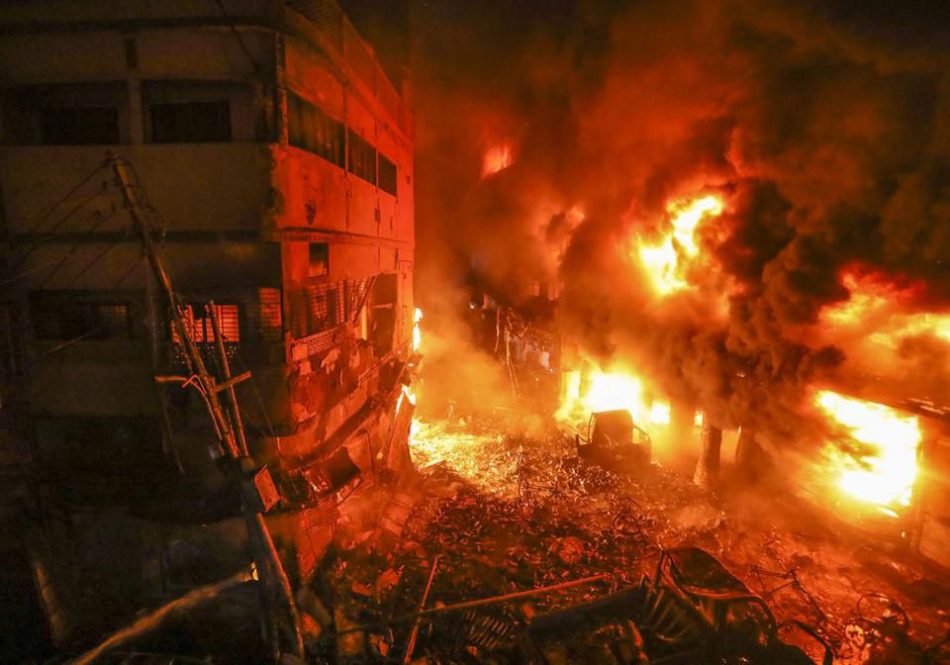
Sweatshop
A small factory where workers are paid very little and work many hours in very bad conditions: Sweatshop conditions
Cammbridge Dictionary
Page Description
Explore the harsh realities of sweatshops and fast fashion.
Learn about worker exploitation, environmental impacts,
and how you can make a difference.
Fast Fashion
Clothes that are made and sold cheaply, so that people can buy new clothes often:
Instead of having two seasons, fast fashion gives us new variations on T-shirts and jeans every week.
The underwear we sell is about luxury, not fast fashion.
Cambridge Dictionary

1 Fast Fashion’s Effect on People, The Planet, & You | Patrick Woodyard | TEDxUniversityofMississippi
8 mrt. 2017
The key points of “Sweatshops and Fast Fashion” include:
Worker Exploitation:
- Poor working conditions
- Low wages
- Long hours
- Lack of workers’ rights
Environmental Impact:
- Pollution from textile production
- Waste from discarded clothing
- Use of harmful chemicals
Economic Factors:
- Global supply chains
- Cost-cutting measures by brands
- Impact on local economies
Ethical Concerns:
- Child labor
- Unsafe working environments
- Human rights violations
Consumer Responsibility:
- Awareness of purchasing choices
- Support for sustainable brands
- Advocacy for better industry practices
Regulation and Reform:
- Efforts to improve labor laws
- Corporate social responsibility
- International agreements and standards

2 Sweatshops: A Sad Truth that still continues
3 Fast Fashion: Sweatshops
28 apr. 2014
4 ‘The True Cost’ – Official Trailer
24 apr. 2015
‘The True Cost’ – Official Trailer
Rent or own the film today! Visit http://truecostmovie.com for more details.
The True Cost is a groundbreaking documentary film that pulls back the curtain on the untold story and asks us to consider, who really pays the price for our clothing?
Original Song ‘I Want It All’ by Natalie Taylor – Available on iTunes: http://apple.co/1DWdeBt
Director: Andrew Morgan
Producer: Michael Ross
Sound Mix & Design: Michael Flowe
Composer: Duncan Blickenstaff
Exec. Producers: Livia Firth & Lucy Siegle
Vincent Vittorio & Christopher L. Harvey
Untold in association with Life Is My Movie Entertainment
‘The True Cost’ – Official Trailer – Blog
5 How to Engage with Ethical Fashion | Clara Vuletich | TEDxSydney
14 jun. 2016
6 Can Fashion Lovers Survive Working In A Sweat Shop? (Social Documentary) | Real Stories
6 mei 2021
7 Life Inside A Sweat Shop (Social Documentary) | Real Stories
22 jun. 2021
 . Glad to see Richard finally swallowed his pride and have that conversation with one of the workers. Just not sure if it was enough to make a permanent impact on how he views people in these circumstances. I do hope it is though
. Glad to see Richard finally swallowed his pride and have that conversation with one of the workers. Just not sure if it was enough to make a permanent impact on how he views people in these circumstances. I do hope it is though
 ️
️8 Textiles: Environmental Impacts (Preview)
14 feb. 2011
9 Are your clothes made in safer factories after the 2013 Bangladesh factory disaster?
24 apr. 2018
26 aug. 2013
11 TEARS IN THE FABRIC (RANA PLAZA DOCUMENTARY 2014)
12 Rana Plaza: Harassment, Anti-Union Tactics in Bangladesh Garment Factories
27 apr. 2015
13 The True Cost: Who Pays the Real Price for YOUR Clothes | Investigative Documentary
7 feb. 2021
16 jun. 2013
15 Fast Fashion: Sweatshops
28 apr. 2014
16 Unravel: The final resting place of your cast-off clothing
30 nov. 2016
When people in the West throw their clothes away, their cast-offs often go on a journey east, across the oceans, to India’s industrial interior. From the Kutch District of western India to the northern city of Panipat, garment recyclers turn into yarn the huge bales of clothes that come from people and places distinctly strange. With little exposure to Western culture other than the Discovery Channel, the garment recyclers rely on their imagination and the rumours that travel with the cast-offs to create an an intriguing perspective on the West.
Director: Meghna Gupta
17 Working In Asia’s Largest Slum (Poverty Documentary) | Real Stories
Back to menu IMPORTANT CONTENT
17 jul. 2021
18 The High Cost of Our Cheap Fashion | Maxine Bédat | TEDxPiscataquaRiver
22 mei 2016
19 The high cost of cheap clothing | Trisha Striker | TEDxTownsville
3 nov. 2016
No one wants to support child, forced or sweatshop labour. Yet, how many of us actually know how and where our clothing is made? Let’s use our buying power and our voices to change the direction the fashion and clothing industry is taking the world, and help end exploitation.
Trisha was born in and spent the first sixteen years of her life in India. As a little girl, Trisha was always burdened by the stark differences in living standards between the ‘rich’ and ‘poor’ and the ill treatment of the most vulnerable in society. This burden only grew as she became more aware of the world and its many problems until finally, she decided to leave India in search of answers. Armed with the desire to understand the world and the determination to develop the knowledge and skills needed to be a part of the solution, she came to Australia in 2004. Trisha is passionate about culture, education, freedom and equality. She is also passionate about finding smart, inclusive, culturally sensitive and sustainable answers to big issues such as gender inequality, poverty, education and exploitation. It was in pursuit of these goals that she began studying Economics at James Cook University, a decision that continually challenges her and broadens her mind.
This talk was given at a TEDx event using the TED conference format but independently organized by a local community. Learn more at http://ted.com/tedx
20 Walk in My Shoes: Nike’s Sweatshops (A Culture Jamming Documentary) | Bonettwork
29 apr. 2020
Bonettwork
8 maanden geleden20 okt. 2011
22 Fashion Victims? A look at working conditions for Cambodia’s garment workers
27 nov. 2013
23 Undercover in a Bangladesh clothing factory
23 mei 2013
16 okt. 2013
25 Undercover: The Refugees Who Make Our Clothes (Panorama) – BBC News
24 okt. 2016
26 The true cost of fast fashion | The Economist
29 nov. 2018
Jarid Gaming
2 jaar geledenOur Changing Climate
2 jaar geleden27 BBC: The Price of Fast Fashion
2 aug. 2019
28 H&M in Bangladesh
29 Tour in Our Garment Factory in Bangladesh
27 nov. 2018
– LEED Gold Certified Factory in Comilla
– One of the global centers of apparel production.
– Warehousing and service to manufacturers
30 Made In Bangladesh – BBC Click
31 How to change the world by fashion consumption | Jochen
7 jul. 2016
Consumers are not aware enough about the negative impact of sustainability within the fashion sector. It will become clear that the fashion industry needs a systematic change. Consumers are the key driver for this development. The presentation gives overall solutions and guidelines how each person can contribute to this change.
Strähle is a full-professor for International Fashion Management at Reutlingen University in Germany. Professor Jochen Strähle is an international fashion management specialist trained at Friedrich-Schiller-University Jena (G), Universidade de Coimbra (PT), and the University of London/Paris (UK/F). He holds a Master and a Ph.D. in Business Administration/ Intercultural Management.
32 How fast fashion adds to the world’s clothing waste problem (Marketplace)
20 jan. 2018
10 nov. 2017
34 Fast Fashion Industry Documentary
25 mei 2015
35 The garment industry in Bangladesh: Made in Bangladesh | Primark
15 jan. 2014
36 Sweatshops and Fast Fashion
19 jan. 2018
37 Where Your Old Clothes Go | Trash Trail | CNA Insider
16 dec. 2020
38 The clothes we wear | DW Documentary
3 mrt. 2020
39 Is Fashion Destroying the Planet? – Ethical Fashion Documentary
6 jan. 2019
40 Fast fashion: The dumping ground for unwanted clothes – BBC News
10 okt. 2021
41 The fast fashion graveyard in Chile’s Atacama Desert – BBC News
7 feb. 2022
42 Fast fashion – The shady world of cheap clothing | DW Documentary
11 feb. 2022
Fast fashion has radically transformed the textile industry. These days, 56 million tons of clothing are sold every year. But cheap garments come at a high price: A precarious existence for workers and a catastrophic environmental impact.
The clothing industry is currently deluging the planet with garments. With 100 billion items produced every year, that’s more than ever before. International companies are locked in an ongoing race to create new styles and win higher profits. And this gigantic expansion is set to continue: The sector is forecast to grow by 60 per cent by 2030.
On the one hand, fast fashion means affordable clothes for all. Zara is known as the original fast fashion brand. The Spanish clothing giant creates 65,000 new styles every year.
Shopping for clothes has become a veritable leisure activity stoked by social media: half of all Instagram posts are related to fashion and beauty. This is how market leaders in fast fashion influence their customers’ buying behavior, backed by relevant neuromarketing specialists.
Fast fashion profits from e-commerce. No more trying on clothes in the store, the customer orders online and has the garment delivered – and if they don’t like it, they just send it back. Throwaway clothes and throwaway work: carried out by an army of couriers within the precarious gig economy.
The textile industry is the sector with the world’s second-highest environmental price tag. Fast fashion manufacturers’ favorite material – viscose made from wood fibers – is marketed as a climate-friendly alternative. But producing this fabric uses a whole range of chemicals. This leads to serious health issues, not only for those working in the factories, but also for people living close by, for example in the Indian state of Madhya Pradesh.
Every year in Europe, four million tons of clothing ends up in the trash. Less than one per cent of this is recycled. The fashion industry likes to parade its sustainability credentials, but the reality is quite the opposite.
Fast fashion – The shady world of cheap clothing | DW Documentary – Blog
43 How 7.5 Million Pounds Of Donated Clothes End Up At A Market In Ghana Every Week | World Wide Waste
9 feb. 2022
44 Toxic Labels: What is Behind Cheap Clothes | Textile Industry | Fashion | ENDEVR Documentary
30 jan. 2022
45 Undercover: The Refugees Who Make Our Clothes (Panorama) – BBC News
24 okt. 2016
46 Hidden Workforce – Child labour in garment Industry Save the Children Delhi
19 jun. 2015
47 The clothes on your back: Factory kids
16 okt. 2013
48 Fast Fashion and Child Labour. Attention!!! Your clothes might have been made by a child!
18 okt. 2020
Around 260 million children are in employment around the world, says the International Labour Organisation.
Of them, 170 million are engaged in child labour.
What do you think, how many out of these 260 million children working, are engaged in the fast fashion industry?
Stay tuned as this video will be dedicated to the issue of child labour in the fast fashion industry.
Video editing : inShot




49 The truth behind fast fashion – Are fashion retailers honest with their customers? | DW Documentary
19 okt. 2021
50 Sweatshops: Deadly Fashion | When Rich Fashion Bloggers Went to Cambodia | Fast Fashion Documentary
The True Cost | Secrets Behind Fashion Industry | Exploitation | Documentary
15 jul. 2021
20 sep. 2021
The True Cost (2015)
Director: Andrew Morgan
Writer: Andrew Morgan
Stars: Livia Giuggioli, Stella McCartney, Vandana Shiva
Genres: Documentary, Drama, News
Country: Bangladesh, USA, Cambodia, China, Denmark, France, Haiti, India, Italy, Uganda, UK
Language: English
Release Date: 21 January 2016 (Germany)
Also Known As: The True Cost – Der Preis der Mode
Filming Locations: Cambodia
Storyline:
This is a story about clothing. It’s about the clothes we wear, the people who make them, and the impact the industry is having on our world. The price of clothing has been decreasing for decades, while the human and environmental costs have grown dramatically. The True Cost is a groundbreaking documentary film that pulls back the curtain on the untold story and asks us to consider, who really pays the price for our clothing?
Reviews:
“This documentary clear shows the exploitative methods used by Big companies and owners and how the slavery has been outsourced to 3rd world countries. This documentary also invokes the responsibility of an average citizen towards our environment. Being a citizen of a 3rd world country like India, i completely understand the situation of the workers in india and the neighboring countries and how our people are being exploited in every industry.
One thing we need to understand is our role in the society. Everyone’s role is being reduced to a role of “consumer”. Think about it.
Don’t worry about the Metascore and Critics reviews. They don’t understand how important this film is.” Written by yssp on IMDb.com.
“It’s really an eye opener to the secrets behind the clothing industry. In fact the western corporates and consumers have blood on their hands by choosing to stay ignorant about the clothing and food industry. It’s sickening how these “happy commercials of lush beauty and nice clothes” are use to fool the world and making it worse and worse for out planet and third world people….SEE THIS AND THINK AGAIN!
Never ever will you buy your clothes without thinking about where it’s coming from and what role it played in the environment and the workers behind these clothes. I hope people will start opening their eyes with this documentary” Written by justsayinme on IMDb.com.
“I have seen many documentaries, but when it comes to human exploitation this is by far the most question arising docu i have ever seen.
what is development? social justice? basic humanity?
when companies in order to reduce their cost prices and increase profits employ destitute people who doesn’t have any alternate career other than being a laborer for a meager salary in sweatshops, and supporting their act by claiming that they are providing livelihood to these wretched lives as if they were not living before these companies came. what do you call it if not social exploitation?
The words spoken by the environmental activist are cent percent true. Fertilizers and seed business in an epidemic in INDIA that is not there before the 1950s. They affected the generations of Punjab region both medically and economically.
Many might think this docu to be an anti-capitalistic propaganda. But developing capitalistic economies at the cost of what? companies might not feel empathy with argument, but a consumer should feel it before falling in the craze of “Brands”. They have to remember those hands that suffered for producing the clothing that you’re buying at “discounted” prices and festive sales.
The least as an audience should you do is give this a higher rating so that the problem is addressed and more people become aware of what “REAL SLAVERY” would look like in the modern world.” Written by mnagaditya on IMDb.com.
“Great documentary about the real price we pay (people and the planet) for fashion and overbuying clothing. At times it seemed that it was repeating and dragging, but overall worth the time. I can no longer justify my clothing donations to charity.” Written by sanmccarron on IMDb.com.
51 An Invitation to a H&M Sweatshop: Hunt for a Living Wage | Bloggers Fight Fast Fashion in Cambodia
27 aug. 2021
52 Corner Store Thief Prank – Throwback Thursday
20 feb. 2014
Luce With Love
2 jaar geleden